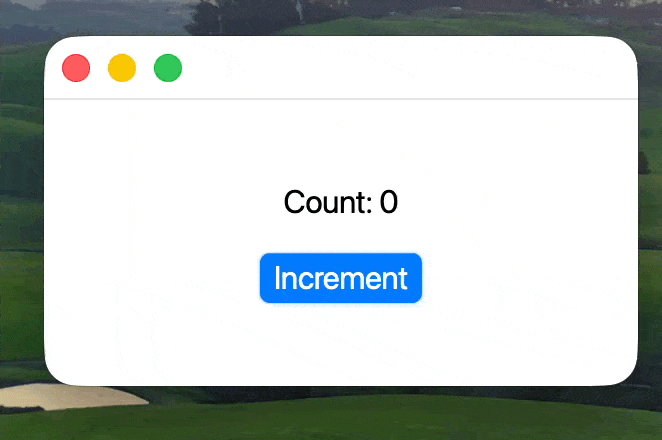Quick Start
Build your first Shaft application in minutes.
Getting Started
Since Shaft is just a regular Swift package, the easiest way to start is using the official starter template CounterTemplate:
# Clone the template
git clone https://github.com/ShaftUI/CounterTemplate.git
# Navigate to directory
cd CounterTemplate
# Run the app
swift runThat’s it! You should see a window with a counter application:

Advanced: Creating a Project from Scratch
For experienced developers who want to set up a project manually:
1. Initialize a new Swift project
mkdir MyShaftApp
cd MyShaftApp
swift package init --type executable2. Initialize Swift Package
Update the Package.swift file to include the Shaft framework:
// swift-tools-version: 5.10
import PackageDescription
let package = Package(
name: "MyShaftApp",
platforms: [.macOS(.v13)],
dependencies: [
.package(
url: "https://github.com/ShaftUI/Shaft.git",
branch: "main"
)
],
targets: [
.executableTarget(
name: "MyShaftApp",
dependencies: [
.product(name: "Shaft", package: "Shaft"), // The core Shaft framework
.product(name: "ShaftSetup", package: "Shaft"), // Desktop backend
]
)
]
)3. Write Your First App
Create Sources/MyShaftApp/main.swift with your app code:
import Shaft
import ShaftSetup
Shaft
runApp(
Text("Hello, Shaft!")
)4. Run Your App
swift runUnderstanding the Code
Let’s break down the hello world example:
Imports
Import the required frameworks to access widgets and functionality:
import Observation
import Shaft
import ShaftSetup- Observation: Swift’s built-in observation framework for reactive programming
- Shaft: The core UI framework
- ShaftSetup: Automatically configures the best backend for your platform
Backend Setup
Initialize Shaft with the default backend:
// Use the default backend
ShaftSetup.useDefault()The Shaft core framework is platform-agnostic by design—it doesn’t depend on any specific OS or windowing system. This makes it easy to port and customize, but it means you need to provide a backend for windowing and rendering.
ShaftSetup simplifies this by automatically configuring the best backend for your platform.
Hot Reload Setup (Optional)
For faster development, enable hot reloading:
#if DEBUG && !os(Windows)
import SwiftReload
LocalSwiftReloader(onReload: backend.scheduleReassemble).start()
#endifThis automatically reloads your app when you make changes to the source code.
Observable State
Create reactive state using Swift’s @Observable macro:
@Observable class Counter {
var count = 0
}
let counter = Counter()- @Observable: Makes the class automatically notify UI when properties change
- var count: The state that will trigger UI updates when modified
Widget Definition
final class CounterView: StatelessWidget {
func build(context: BuildContext) -> Widget {
Column(mainAxisSize: .min, spacing: 16) {
Text("Count: (counter.count)")
Button {
counter.count += 1
} child: {
Text("Increment")
}
}
.center()
}
}- StatelessWidget: A widget that doesn’t maintain internal state
- Column: Arranges children vertically with spacing
- Button: Interactive widget with click handler
- Text: Displays content, automatically updates when
counter.countchanges
Running the App
runApp(
CounterView()
)Launches the application with your root widget.
Building a Counter App
Let’s create something more interactive:
Next Steps
Now that you have a working Shaft application:
- Learn about Widgets - The building blocks of Shaft UI
- Explore State Management - Managing application state
- Check out more Tutorials - Real-world applications